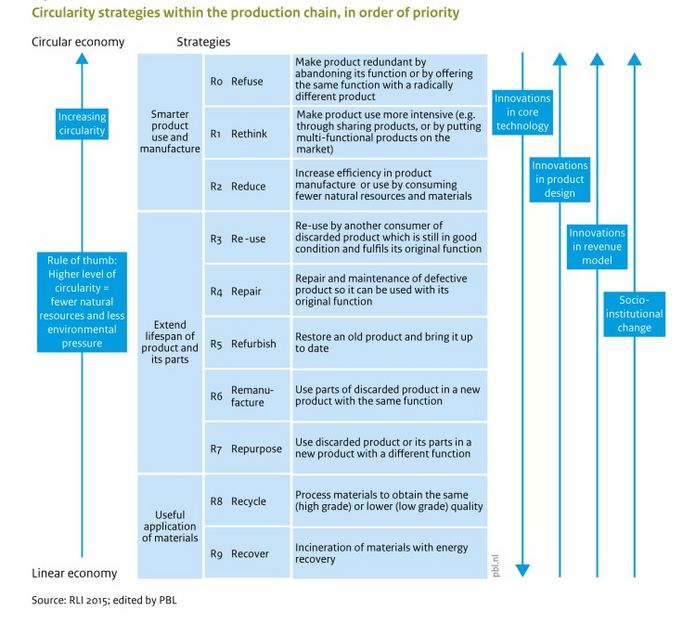Information on collaboration for entrepreneurs
Why this tool?
As an entrepreneur in the leisure industry, it can be challenging to get started with a circular initiative, where do you start? And how do you do it? Therefore, this tool is developed to support you taking the first steps into the circular economy, the different ways to get involved, and how to get involved into circular entrepreneurship in collaboration with other entrepreneurs.
Circular economy breaks the standard linear relations between clients and providers, as it is a joint effort between the different actors of circular economy to create value at different steps along the supply chain. It could be roughly summed up that one person's waste is another's resource. The circular economy offers opportunities for entrepreneurs who want to grow and do business sustainably, without harming the opportunity of future generations to do the same.
In a circular economy, raw materials are used more consciously, for longer and recovered for reuse. This can be done in various ways. For example, products are given a longer life, can be repaired or serve as raw materials for a new product. However, each of these ways has its own level of circularity: each effort has its own degree of impact. A great tool to determine those levels, is by applying the 9R strategies, which is explained in the next section.
Once an entrepreneur is introduced to the levels of circular economy, there is a section on about possible cooperation within the value chain: to achieve circularity, the linear value chain as we know it today, next be turned into a circular process, with every part of the chain contributes optimally. With visual models, we describe how to go about this use of the Value Chain Model and territorial support groups that cover the relevant actors in the structure and how they interact, developed by the researchers at FACET. Going further, we also develop a model for collaboration structures to jointly purchase circular products or services by developing the the joint purchase model.
What are we talking about?
Circular economy
We only have one planet. We overconsume natural resources such as water, energy, crude oil, timber and minerals. These resources are needed for the leisure industry to make food, fuel, accommodations, and raw materials to manufacture a broad range of products. When managed well, consumed renewable resources could be restored in a short time. As the total amount of available resources decreases, the more expensive such materials become. The majority of resources used today however are non-renewable and are set to become increasingly scarce based on the current rising demand and unsustainable consumption.
Circular entrepreneurship is a way of doing business based on a product lifecycle standpoint in which sustainable actions such as the reuse of natural resources, raw materials, and manufactured products are being maximized to minimise the loss of its value. As an example, in circular entrepreneurship discarded products can be re-used or brought back to raw material (in an environmentally friendly manner) to manufacture new products.
Circularity is a common goal. A circular economy based on a circular product lifecycle is not just one producer who changes one product; it is about collaboration between connected companies and institutions who jointly transform their current (most commonly), linear business models, into a circular business. With the support of a network of entrepreneurs, companies become more innovative and inspired to create new revenue models collectively.
9-R Strategies
The central element of the implementation of the circularity is the change of the companies' business models, which they adapt through so-called R-strategies. In the following part, we present the 9-R framework by Potting et al. (2017, p. 5).
Several circularity strategies exist to reduce the consumption of natural resources and materials, while minimising the production of waste. They can be ordered according to their levels of circular strategies.
Photo source 9-R: Potting, J., Hekkert, M. P., Worrell, E., & Hanemaaijer, A. (2017). Circular economy: measuring innovation in the product chain. Planbureau voor de Leefomgeving, (2544).
Ideally, all materials stay within the economic production and consumption system. As a rule of thumb, more circularity equals more environmental benefits. This ultimate form of circularity, in which a product chain is closed as the resources can be reused , while retaining their original quality. In the perfect circular world, waste will become a concept of the past.
More information
More information about circularity strategies together with useful examples can be found in the following document developed by FACET researchers:
In addition a generic business Circular economy toolkit was also designed within the project with an explanation and examples on the 9R strategies to encourage the adoption of circular practices by businesses. The toolkit is an easy to read booklet including tips, advice, and contact information for local UK CE schemes. The toolkit offers ideas to businesses such as reconsidering the material of packaging, reducing menu size, donating surplus produce, swapping out SUP with reusable products and much more.
Collaboration in the circular economy
Now that you as an entrepreneur have more background information on the circular economy in tourism and the strategies that exist to apply it, we would like to support you as an entrepreneur in setting up collaboration networks to for efficiency in circular entrepreneurship. We believe these structures provide a valuable foundation for entrepreneurs in implementing circularity within their own businesses.
Circular value chain model
This model is developed within FACET based on the 9R-strategies and an example of a value chain used by the SITRA Fund in Finland. The objectives were to create an attractive and fun working method for entrepreneurs to crystallize their ideas on paper and work together around these value chain models. At the same time, making sure the selected ideas have the ‘circular’ component in their DNA by using the 9R’s.
The model serves to visualise the way a linear product or service value chain can become a circular value chain. The model guides the user to use one of the previously described R-strategies at each part of the value chain. As resources are kept within the value chain, the user of a product can become the supplier of the resources for a new circular product, which requires new collaborations and partnerships between businesses.
Joint purchase model
In addition to the model to encourage collaboration in the value chain, within FACET want to support the scaling of circular initiatives by zooming in on joint procurement. Taking this step will make it clear to you as an entrepreneur how good cooperation can also be of valuable in financial terms.
Joint purchasing agreements are arrangements between (groups of) providers to purchase services, equipment and supplies. The aim of joint purchase agreements is to create buyer power which will lead to lower prices or better quality of products or services.
Providing entrepreneurs with tools for joint purchasing
Many entrepreneurs in the tourism & hospitality sector want to be more sustainable and shift to circular business practices. Where traditionally decisions were mostly based on financial impacts, nowadays also social and environmental impacts are becoming more relevant in the decision-making process.
One opportunity to do so, is the joint-purchase of products and/or services. The main reasons for collaborating over joint purchases for the circular economy is twofold: to obtain benefits of reduced costs while lowering the environmental costs of that purchase. Entrepreneurs can also benefit in other ways from taking part in such agreements such as the exchange of knowledge and best practices.
The model
A model is a simplification of reality, which in itself is far more complex and unique. However, a model can help us to understand and make sense of reality and provide some common ground. Taking this into account we chose to create a Joint Purchase-model that is process-oriented and provides a checklist approach to organize a collaborative project.
Goal of the model
Our goal is to enable entrepreneurs to introduce circular economy principles into their purchasing activities and thereby create financial, social and environmental value. The 2-pager is a summary of the accompanying report that includes the key steps of the joint purchase process in conjunction with a sample case. The report provides a comprehensive explanation of joint purchase and an explanation of the steps in this process. This report can be seen as a guideline that gives you a brief overview on the criteria for joint purchasing, some best-practices from other sectors and insights in different strategies that make such arrangement suitable for the Circular Economy. Furthermore, we present a working model that helps structure the collaboration process for Joint-Purchase in seven steps.
In this 2-pager we give you a quick overview.
The report provides a comprehensive explanation of joint purchase and an explanation of the steps in this process.
Circular support groups
Quadruple Helix
In the project FACET we learned that collaboration of small to medium enterprises, within a circular support group (CSG), is key to the success of circular innovations. The reason is two-fold: driving innovation is easier when working together and by connecting government, business, academia and civil society we strengthen our local economy. One entrepreneur can have an idea, but if that is shared by a group of entrepreneurs, validated by scientific research, supported by local communities, funded by government within the appropriate policy framework and an industry that can provide the products and services to make it happen. Regions must build on their own strengths by connecting government, business, academia and civil society, an approach also called Quadruple Helix. The Quadruple Helix entails several meetings that focuses on how to foster an innovative environment for organizations and help them to develop better products and services. As such, partners in the Quadruple Helix (business, knowledge institutes, government, civil society) strive to have a positive effect on business climate and society in general. Within FACET we have developed two models that present two scenario’s for collaboration between the above mentioned stakeholders to support small to medium enterprises (SME’s) in their development of circular initiatives.
The next 2 pager explains the models and presents a real-life example of what this quadruple helix looks like in practice.
In addition to the quadruple helix, the project partners translated the quadruple helix model to an action plan for creating circular support groups. A way to accelerate the uptake of circular economy practices in the coastal tourism sector is making use of regional support groups that cover the relevant chain of actors. A circular support group is a network that should boost circular initiatives of tourism entrepreneurs, as it includes the views of researchers, civil society, government and industry stakeholders. Therefore, the aim of the action plan is to develop a generic, replicable methodology for circular support groups for accelerating circular economy practices in the coastal tourism sector.
The action plan consists out of six steps for building a circular support group.
In addition to the action plan an evaluation of the Circular Economy support group models was conducted.
Want to know more about working together or need help?
In this tool, we have tried to take you through the principles of circular economy and ways to set up collaborations to realise its principles within your own business. Do you have any questions or comments about this? If so, please contact us. Do you need insight on how to implement the circularity within your own company? Take a look at the following toolkit (Circular Economy Toolkit for Tourism Entrepreneurs). Can we help you with inspiration and examples when it comes to practical application of circular economy strategies within your own company? Then take a look at our best practices. Good luck and please share your developments with us!


